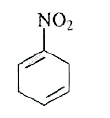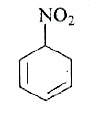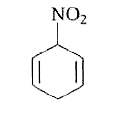Aniline can be obtained by reduction of nitrobenzene with
Stannous chloride and hydrochloric acid
hydrogen ,Pt
Zinc and sodium hydroxide
Zinc and ammonium chloride
The correct Answer is:B
To determine how aniline can be obtained from the reduction of nitrobenzene, we will follow these steps:
1. Identify the Reactants:
- The starting compound is nitrobenzene, which has the chemical formula C6H5NO2. It contains a benzene ring (C6H5) with a nitro group (NO2) attached.
2. Understand the Reduction Process:
- The reduction of nitrobenzene involves converting the nitro group (NO2) into an amino group (NH2) to form aniline (C6H5NH2).
3. Choose the Reducing Agent:
- Common reducing agents for this reaction include hydrogen gas in the presence of a catalyst (like platinum, palladium, or nickel) or metals such as tin (Sn) in combination with hydrochloric acid (HCl).
4. Write the Reaction:
- Using hydrogen gas and a platinum catalyst, the reaction can be represented as:
C6H5NO2+H2Pt−→C6H5NH2+H2O
- Alternatively, using tin and hydrochloric acid:
C6H5NO2+Sn+HCl→C6H5NH2+SnCl2+H2O
5. Evaluate the Options:
- From the options given:
- Stannous chloride and HCl (this is correct as it involves tin and HCl).
- Hydrogen in the presence of platinum (this is also correct).
- Zinc in the presence of sodium hydroxide (not commonly used for this reduction).
- Zinc in the presence of ammonium chloride (not commonly used for this reduction).
6. Conclusion:
- The correct methods to reduce nitrobenzene to aniline are using either stannous chloride with hydrochloric acid or hydrogen gas with a platinum catalyst.
Final Answer:
Aniline can be obtained by the reduction of nitrobenzene with:
- Stannous chloride and HCl
- Hydrogen in the presence of platinum catalyst
- The starting compound is nitrobenzene, which has the chemical formula C6H5NO2. It contains a benzene ring (C6H5) with a nitro group (NO2) attached.
- The reduction of nitrobenzene involves converting the nitro group (NO2) into an amino group (NH2) to form aniline (C6H5NH2).
- Common reducing agents for this reaction include hydrogen gas in the presence of a catalyst (like platinum, palladium, or nickel) or metals such as tin (Sn) in combination with hydrochloric acid (HCl).
- Using hydrogen gas and a platinum catalyst, the reaction can be represented as:
C6H5NO2+H2Pt−→C6H5NH2+H2O
- Alternatively, using tin and hydrochloric acid:
C6H5NO2+Sn+HCl→C6H5NH2+SnCl2+H2O
- From the options given:
- Stannous chloride and HCl (this is correct as it involves tin and HCl).
- Hydrogen in the presence of platinum (this is also correct).
- Zinc in the presence of sodium hydroxide (not commonly used for this reduction).
- Zinc in the presence of ammonium chloride (not commonly used for this reduction).
- The correct methods to reduce nitrobenzene to aniline are using either stannous chloride with hydrochloric acid or hydrogen gas with a platinum catalyst.
Aniline can be obtained by the reduction of nitrobenzene with:
- Stannous chloride and HCl
- Hydrogen in the presence of platinum catalyst
Topper's Solved these Questions
- AMINESBOOK - VMC MODULES ENGLISHCHAPTER - AMINESEXERCISE - ENABLE
45 Videos
- AMINESBOOK - VMC MODULES ENGLISHCHAPTER - AMINESEXERCISE - EFFICIENT
49 Videos
- ALDEHYDES,KETONES & CARBOXYLIC ACIDS BOOK - VMC MODULES ENGLISHCHAPTER - ALDEHYDES,KETONES & CARBOXYLIC ACIDS EXERCISE - IN-CHAPTER EXERCISE-M
10 Videos
- ATOMIC STRUCTUREBOOK - VMC MODULES ENGLISHCHAPTER - ATOMIC STRUCTUREEXERCISE - JEE Advanced (Archive )
67 Videos
Similar Questions
Knowledge Check
Birch reduction of nitrobenzene will produce :
A B
B C
C D
D
Which of the following give aniline by reduction of nitrobenzene?
AH2/Pd−CBSn+HClCFe+HClDLiAlH4
Aniline can be prepares by :
View SolutionProduct obtained by electrolytic reduction of nitrobenzene in presence of H2SO4 s
View SolutionThe product obtained by reduction of benzyl bromide with LIAIH4 is
View SolutionPrimary alcohols can be obtained can be obtained from the reaction of the RMgX with
View SolutionWhich of the following products can be obtained by reductive ozonolysis of o-xylene ?

View SolutionAlkali metals can be obtained by chemical reduction of their compounds.
View Solution
